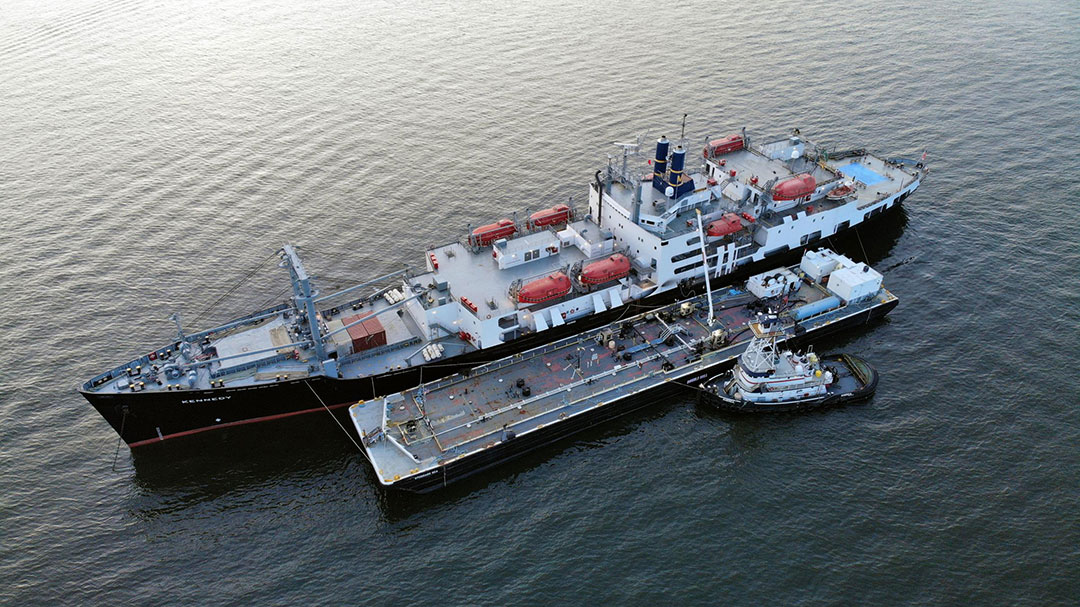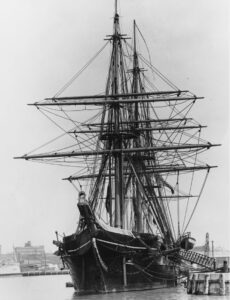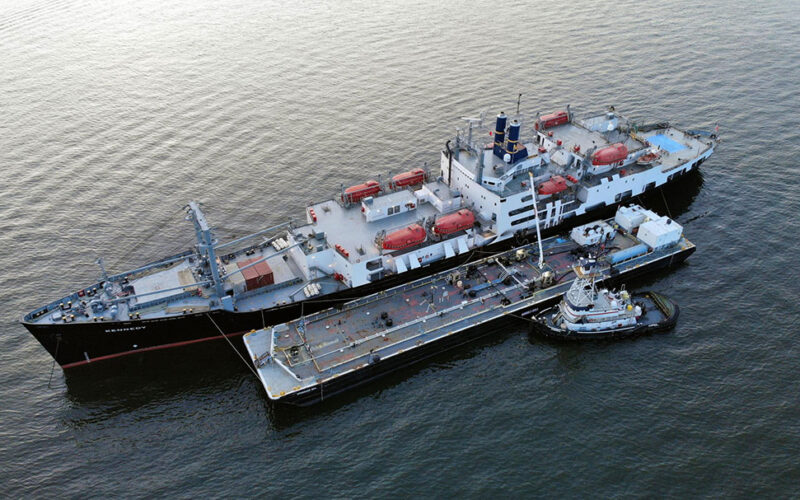
While there are substantial differences between the maritime environment of the sunny, alluvial Texas shores and the craggy, “rock-bound” coast of Maine, the maritime training schools in both states, Texas A&M Maritime Academy (TAMMA) and Maine Maritime Academy, respectively, are celebrating or looking forward to celebrating upgrades in their training vessels.
In the case of Texas, the immediate cause for celebration is the permanent arrival of the former Massachusetts Maritime Academy training ship, TS Kennedy, shared by the two states since 2018.
Successful legislative efforts made that transfer possible and helped create funding for the National Security Multi-Mission Vessel (NSMV) TS Lone Star State – one of a class of five State Class vessels built by the Philly Shipyard with each destined for a state maritime academy.
The 540-foot TS Kennedy, while not up to the standard of the new NSMV, is a big step up from the vessel it’s replacing – the 224-foot TS General Rudder – and will offer the potential for year-round training in ship navigation and marine engineering systems, maintenance, safety, and security.
Some 18 years have passed since Texas A&M operated a training vessel capable of fully supporting all its students. But Kennedy’s age, among other factors, makes it at best a stopgap. The ship began life in 1967 as the SS Velma Lykes, a Maritime Administration-subsidized C-4 break bulk freighter that filled many roles prior to joining the nation’s maritime academy fleet.
Texas A&M Maritime Academy took operational control of Kennedy in April 2023 and the vessel will remain in service with the school until the TS Lone Star State is delivered in the summer of 2025, according to Rebecca Watts, executive director of marketing and communications for the Galveston-based Maritime Academy.
“The industry’s workforce is aging and retiring; training the new generation of mariners and maritime professionals is essential to support this critical industry,” she said. “The Lone Star State is to us what Kyle Field is to Texas A&M in College Station. It’s a tremendous recruiting resource, and just as importantly, it will elevate the student education and training experience.”
The NSMV series, specifically built for training purposes, is a tremendous opportunity for every state maritime academy to provide enhanced education and training, explains TAMMA Superintendent, Rear Admiral Michael E. Fossum.
Each of the schools had input into the development of the NSMV design, he said, adding that, “It is our understanding that the ships [of each academy] will differ in name only.”
Over the past 150 years, state maritime training ships have seen extensive prior service as Navy vessels, often near the end of their useful life.

The first U.S. merchant marine training ship was the U.S.S. St. Mary’s – a wooden U.S. Navy sloop of war – built in 1844 and acquired by the New York Public Marine School, now the State University of New York Maritime Academy, in 1875. The vessel served as a school ship until June 1908 when it was scrapped.
“The NSMV is the first time the U.S. has created a training ship from the keel up with designed training spaces and a collegiate fit and finish,” says RADM Fossum. “This allows training on state-of-the-art equipment and the ability to upgrade these spaces as new technologies and training methods come online. The ships will also have cadet staterooms of four-to-eight persons instead of mass congregate berthing in converted cargo holds.”
The considerable bill for construction of all five vessels in the class stands at some $1.5 billion with the construction of the vessels completely funded by federal appropriations and operations jointly financed by federal and academy sources, he explained.
A key feature of the NSMV class is that the ships are designed for as-needed activation for service during emergency relief and military sealift situations. But, Fossum notes, in such an eventuality, all efforts will be made to restrict the impact on training.
Craig Johnson, chief operating officer at Maine Maritime, says the concept of creating a more modern training fleet began in Congress some 20 years ago, with legislators starting to recognize that passing aging vessels through the academies on their way to the breakers was neither efficient in terms of the efforts needed to make them serviceable for students nor in terms of actually being really suitable for their mission.
Some people began to ask whether it would be possible to build ships for maritime training and other specialized missions right from the start. The eventual answer was the NSMV, he says.
Johnson says delivery of State of Maine, the fifth academy vessel to bear the name, sits in the middle of the state-by-state deliveries. “My understanding is the sequence was based on the comparative age of each of the existing training vessels, SUNY was oldest, at just over 60 years, Massachusetts Maritime and State of Maine followed.”
Like TAMMA’s Watts, Johnson says the positive impact of the new NSMV will be “immense,” he said. “Our current ship cannot house the student body. We can accommodate 220 now, but we should be shipping three hundred.”
A Maine Maritime graduate himself, Johnson spent seven years in the engineering departments of tankers. Having a modern, first-class vessel at the school “is especially important since most of our people have always gone to sea and tend to stay at sea for longer parts of their career, whether they train for engineering or deck roles,” he said.
The nationwide shortage of mariners, he added, is compounded by the rising standards and levels of testing. There are few paths available without formal training. “You can still come up the hawsepipe, but that’s not easy.”

